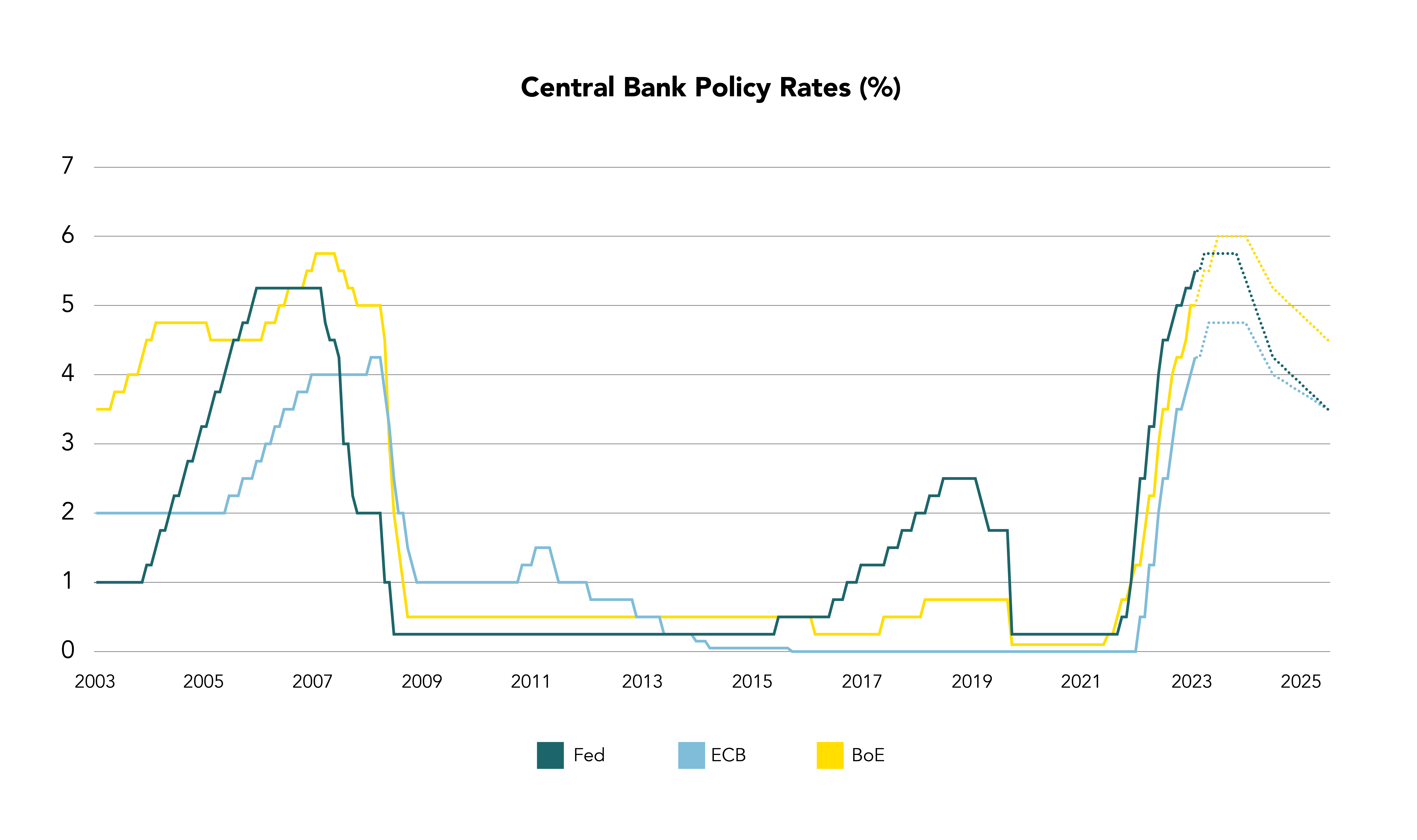As economic growth and headline inflation ease, the prospect of higher interest rates for longer becomes increasingly unlikely. US inflation is now about 3% – down more than six percentage points from the peak last year and lower than in Japan. In the Eurozone, inflation is almost half of 2022’s peak of 10.6%. However, central banks have chosen to keep their cards close to their chest on potential future rate changes, opting instead to buy more time to assess incoming data. This is because core inflation (which strips out food and energy) is still high, particularly in the UK where it has declined minimally.
So, despite the positive market reaction to falling headline inflation, the fight is not won yet, but we believe we’re entering the final round. We expect the US Federal Reserve (Fed) likely has one rate increase left, or perhaps it won’t even have to raise rates any further. The European Central Bank (ECB), however, is poised to continue to push interest rates higher for a little while longer. The Bank of England (BoE) has a much tougher job on its hands to combat persistently high inflation in the UK. It has acknowledged that a recession may be necessary to make meaningful headway in bringing down inflation. While there’s significant uncertainty on the level BoE rates will likely reach in the UK, we now expect a peak of 6%.
Like the West, Asian economies are also grappling with the impact of slowing manufacturing and global growth, compounded by lingering trade tensions. Nevertheless, without the worry of high inflation, a glimmer of hope remains with potential policy support through low rates and fiscal stimulus, particularly in China. Japan, on the other hand, is experiencing a period of economic and earnings recovery, as well as positive inflation trends and structural reform.
Overall, things remain quite uncertain out there. This is why we are sticking to our cautious approach to portfolio positioning of high-quality bonds, coupled with quality dividend payers in the US and low-volatility equities in the US and Europe. This, plus a slight tilt towards Asia-Pacific including Japan equities, should help capture some of the upside while protecting portfolios if market volatility was to pick up.


Daniele Antonucci, Co-Head of Investment & Chief Investment Officer
Headline inflation is slowing across the globe, but core inflation (excluding food & energy) remains elevated. Pandemic constraints have eased and manufacturing activity has slowed, pushing headline inflation lower. While slowing too, the level of core inflation is still too high, mainly because services activity has been resilient. The US has seen a bigger inflation decline and so the Fed looks set to pause sooner rather than later. Despite the latest inflation report showing a slightly bigger decline versus expectations in the UK, the level of inflation remains very elevated, suggesting more Bank of England rate increase ahead. The ECB is in between.

Source: In-house research, Refinitiv; dotted lines = own forecasts.
What’s happening?
In our Mid-Year Outlook, we touched on the fact that a 6-month T-Bill was yielding slightly more than the S&P 500. Since then, the gap in the US has grown and the UK has joined the party with the 10-year gilt yield overtaking the FTSE 100 dividend yield. So, despite the current low levels of volatility, the risk-reward of equities appears to have worsened in the near term.
As central banks continue to increase rates in response to inflation, short-term sovereign bond yields are also increasing. But given that inflation is continuing to ease, we believe the upside is limited. This makes high-quality bonds attractive at their current levels.
What we’re watching
In the UK, the inflation outlook is still uncertain, and we now forecast that the Bank of England will raise rates to 6%. Market pricing has been swinging wildly, from 6.5% to about 5.85% at the time of writing. Gilt yields have risen over the past weeks, providing a higher yield compared to the FTSE 100 dividend yield. Despite this, we’re not raising our exposure to gilts just yet, though we acknowledge that they look increasingly more attractive, and instead wait for the inflation outlook to become clearer.
Against our expectations, Asia-Pacific equities have lagged global equities. Japan, Taiwan, South Korea, and lately Indian equities have performed well, but Chinese equities have disappointed. The post-Covid activity surge has recently slowed in China. This is driven by a global manufacturing slowdown and renewed property weakness.
Despite the mixed performance, we still hold our positive view on Asia-Pacific equities. The lack of inflationary pressures compared to the West means that central banks in the region can support economies by keeping rates low without fear of spiralling inflation. This, coupled with relatively attractive equity valuations, supports our positive outlook, especially in the context of our more defensive positioning.
In the fixed income space, we are keeping a watchful eye on the UK gilt market. With strong wage growth and accelerating core inflation, the BoE could be forced to raise rates to 6%. This means UK gilts look increasingly attractive. At the time of writing, they provide a higher yield than the FTSE 100. However, at this stage we’re not raising our gilt exposure just yet. Instead, we’re waiting for a clearer picture to emerge on the path to easing inflation.
Year-to-date, our flagship portfolios continue to perform positively, driven by our long-term allocations to global equities and bonds. Despite this positive performance, our 12-month view remains cautious. We continue to prefer high-quality bonds over riskier equity markets and high-yield bonds.
N = neutral weighting of asset class vs strategic (long-term) asset allocation
Important Information
Information correct as of 1 August 2023.
This document is designed as marketing material. This document has been composed by Brown Shipley & Co Ltd ("Brown Shipley”). Brown Shipley is authorised by the Prudential Regulation Authority and regulated by the Financial Conduct Authority and the Prudential Regulation Authority. Registered in England and Wales No. 398426. Registered Office: 2 Moorgate, London, EC2R 6AG.
This document is for information purposes only, does not constitute individual (investment or tax) advice and investment decisions must not be based merely on this document. Whenever this document mentions a product, service or advice, it should be considered only as an indication or summary and cannot be seen as complete or fully accurate. All (investment or tax) decisions based on this information are for your own expense and for your own risk. You should (have) assess(ed) whether the product or service is suitable for your situation. Brown Shipley and its employees cannot be held liable for any loss or damage arising out of the use of (any part of) this document.
The contents of this document are based on publicly available information and/or sources which we deem trustworthy. Although reasonable care has been employed to publish data and information as truthfully and correctly as possible, we cannot accept any liability for the contents of this document, as far as it is based on those sources.
Investing involves risks and the value of investments may go up or down. Past performance is no indication of future performance. Currency fluctuations may influence your returns.
The information included is subject to change and Brown Shipley has no obligation after the date of publication of the text to update or amend the information accordingly. Accordingly, this material may have already been updated, modified, amended and/or supplemented by the time you receive or access it.
This is non-independent research and it has not been prepared in accordance with legal requirements designed to promote the independence of investment research, and that it is not subject to any prohibition on dealing ahead of the dissemination of investment research.
All copyrights and trademarks regarding this document are held by Brown Shipley, unless expressly stated otherwise. You are not allowed to copy, duplicate in any form or redistribute or use in any way the contents of this document, completely or partially, without the prior explicit and written approval of Brown Shipley. Notwithstanding anything herein to the contrary, and except as required to enable compliance with applicable securities law. See the privacy notice on our website for how your personal data is used (https://brownshipley.com/en-gb/privacy-and-cookie-policy).
© Brown Shipley 2023




